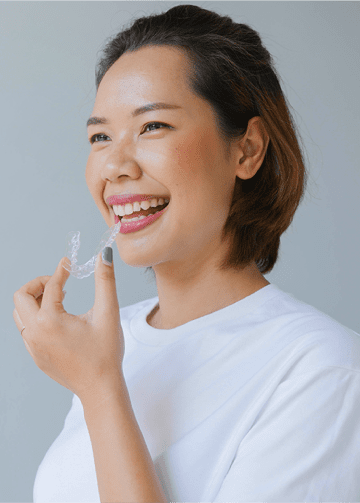$0 Down on Braces
Everybody gets approved.
Payments as low as $147/month
No payments due for 30 days
No impact on credit score
$79 New Patient Exam,
X-Rays & Cleanings
New patients only.
Offers cannot be combined.


Payments as low as $147/month
No payments due for 30 days
No impact on credit score
Offers cannot be combined.



Visiting the dentist for your regular biannual visits allows us to provide you with preventive care and catch dental issues earlier on. As opposed to only coming in when there is a problem, regular dental visits help keep your smile in good shape and save you money and time in the long run.

Flossing cuts down on the amount of bacteria in your mouth. While brushing helps reduce the bacteria, flossing reaches the places a toothbrush cannot, dislodging food particles and removing plaque. You should floss at least once a day.

Brushing for at least two minutes twice a day and flossing daily is one of the best ways to eliminate bacteria in your mouth. In addition to maintaining good oral hygiene habits, being mindful about sugar and acidic drinks and foods also helps prevent cavities.
The best way to prevent cavities and periodontal disease is by good tooth brushing and flossing techniques performed daily, along with professional cleanings at regular intervals.
Periodontal disease and decay are both caused by bacterial plaque. Plaque is a white to colorless film, which sticks to your teeth at the gumline and sometimes collects stains. Plaque constantly forms on your teeth. By thorough daily brushing and flossing you can remove these germs and help prevent cavities, gum disease, and tooth loss.
If you have any pain while brushing or have any questions about how to brush properly, please be sure to call us. Our doctors recommends using a soft tooth brush. Position the brush at a 45 degree angle where your gums and teeth meet. Gently move the brush in a circular motion several times using small, gentle strokes. Hold your toothbrush in your fingertips instead of your fist to ensure you are applying light pressure.
When you are done cleaning the “cheek sides” of all your teeth, follow the same directions while cleaning the. “tongue sides” of your teeth. To clean the “tongue sides” of the upper and lower front teeth, hold the brush vertically. Make several gentle back-and-forth strokes over each tooth. Don’t forget to gently brush the surrounding gum tissue.
Next you will clean the biting surfaces of your teeth by using short, gentle strokes. Change the position of the brush as often as necessary to reach and clean all surfaces. Try to watch yourself in the mirror to make sure you clean each surface. After you are done, rinse vigorously to remove any plaque you might have loosened while brushing.
Periodontal disease usually appears between the teeth where your toothbrush cannot reach.
Flossing is a very effective way to remove plaque from those surfaces. However, it is important to develop the proper technique. The following instructions will help you, but remember it takes time and practice.
Start with a piece of floss about 18” long. Lightly wrap most of the floss around the middle finger of one hand. Wrap the rest of the floss around the middle finger of the other hand. To clean the upper teeth, hold the floss tightly between the thumb and forefinger of each hand. Gently insert the floss tightly between the teeth using a back-and-forth motion. Do not force the floss or try to snap it in to place. Bring the floss to the gumline then curve it into a C-shape against one tooth. Slide it into the space between the gum and the tooth until you feel light resistance. Move the floss up and down on the side of one tooth. Remember there are two tooth surfaces that need to be cleaned in each space. Continue to floss each side of all the upper teeth. Be careful not to cut the gum tissue between the teeth. As the floss becomes soiled, turn from one finger to the other to get a fresh section. To clean between the bottom teeth, guide the floss using the forefingers of both hands. Do not forget the back side of the last tooth on both sides, upper and lower.
When you are done, rinse vigorously with water to remove plaque and food particles. Do not be alarmed if during the first week of flossing your gums bleed or are a little sore. If your gums hurt while flossing you could be doing it too hard or pinching the gum. As you floss daily and remove the plaque your gums will heal and the bleeding should stop.
Sometimes after dental treatment, teeth are sensitive to hot and cold. This should not last long, but only if the mouth is kept clean. If the mouth is not kept clean the sensitivity will remain and could become more severe. If your teeth are especially sensitive consult with our office. We may recommend a medicated toothpaste or mouth rinse made especially for sensitive teeth.
There are so many products on the market it can become confusing and choosing between all the products can be difficult. Here are some suggestions for choosing dental care products that will work for most patients.
Automatic and “high-tech” electronic toothbrushes are safe and effective for the majority of the patients. Oral irrigators (water spraying devices) will rinse your mouth thoroughly, but will not remove plaque. You need to brush and floss in conjunction with the irrigator. We see excellent results with electric toothbrushes from Phillips Sonicare ,Oral-B and irrigators by Waterpik. There are also tiny brushes (interproximal toothbrushes) that clean between your teeth. If these are used improperly you could injure the gums, so discuss proper use with your doctor. We generally recommend Soft-picks by G.U.M. Fluoride toothpastes and mouth rinses, if used in conjunction with brushing and flossing, can reduce tooth decay. Remember, the rinses are not recommended for children under six years of age.
Anti-plaque rinses, approved by the American Dental Association, contain agents that may help bring early gum disease under control. Use these in conjunction with brushing and flossing, and talk to us about which rinse is right for you. We can suggest over-the-counter, prescription, and natural home-made rinses.
Daily brushing and flossing will keep dental plaque to a minimum, but a professional cleaning will remove calculus (hardened plaque also known as tartar) in places your toothbrush and floss have missed.
Your visit to our office is an important part of your program to prevent gum disease and tooth loss. We once thought tooth loss was an inevitable part of aging, but now we know that professional prevention will help you keep your teeth for your lifetime!
At Dentistry and Braces group, we believe that everyone deserves exceptional dental care, no matter their age or circumstance.
For personalized, comprehensive dental care, contact our experienced dentists and make your appointment today.